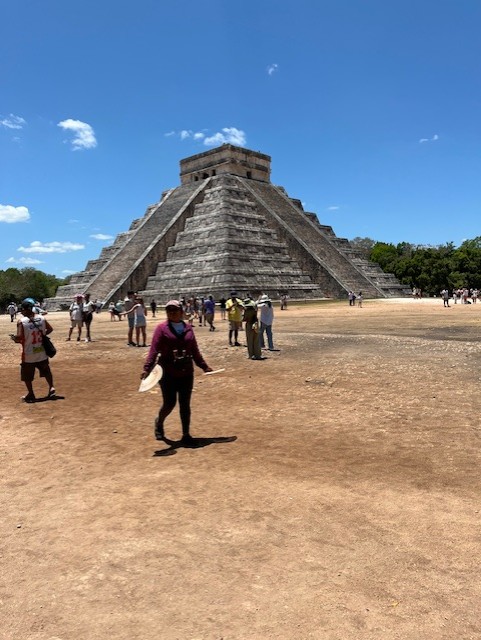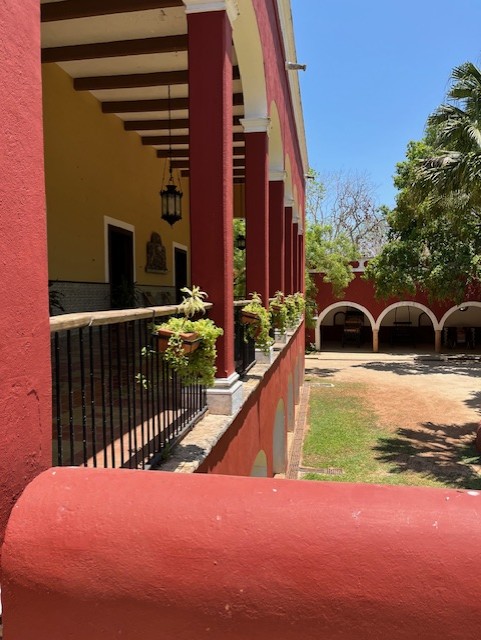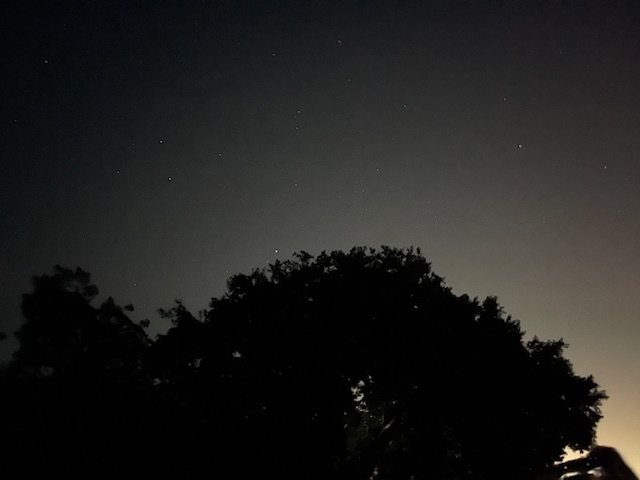As someone who has interacted with Mayan culture and has visited Mayan archeological sites before the trip, I assumed that our month long stay would be an elongation of my week trip in Belize, but I was swiftly proved wrong. During my senior year of college, my philosophy teacher hosted a tour of Belize in which we barely interacted with locals, stayed in our group of American students, and lived in the bubble of stereotypical tourism, basically the opposite of our stay in Merida. Everyday, I went out into the city and explored the crowded markets, the historical architecture, the local foods, and the parks. I would see many familiar faces each time going to my favorite (and the closest) park, El Parque de los Hidalgos. Even though we only lived here for a month, I’ve learned countless things about the colonial history of Merida through all our museum visits and my place as a tourist in the city.
As IFSA said during the orientation, the local people were extremely nice to us tourists, and I felt extremely safe walking in this beautiful town with a clear mind that I still classify as a tourist, which became apparent being approached by vendors in parks who spoke English who mainly seek out tourists, which made me feel guilty. Why should they have to learn our language? Tourism is such a complex topic in how it is so important in Merida’s economy, seen by the large amounts of areas getting gentrified, but in that people are losing their cultures and their land. The former areas that now are a Dairy Queen, Starbucks, or McDonalds must have thousands of memories by so many people associated with it that are now all smashed to dust with the demolition of the building. It is disheartening to see the effect of American neocolonialism with the commodification of the Mayan culture.

In Cannibal Tours (1989) a documentary in Papua New Guinea showing the effect of tourism and the “othering” of the native people, the tourists were indifferent to the culture and saw it and the people as a spectacle. The native people relied on being seen as objects and selling their culture for profit, but there was no other choice. The Italian tourists speaking about about how the indigenous people were less evolved and needed help and assistance is exactly how I imagine the Spaniards when they first discovered the Yucatan, with their ignorance to the Mayan culture. Seeing this as a land and a group of people who need to change to fit their catholic narrative, they exploited the labor, land, and culture of the Mayan people.
This in relation to our excursion to Chichen Itza is devastating. The architecture of the giant structures were stunning but it seemed more like a tourist attraction than an historic site, crowded with tourists and their counterparts, the vendors. Our tour guide was informational and sweet but the tour seemed ingenuine due to the sheer number of people. I ended up thinking: how many times a day does he give out these tours, and how word for word are they? There were countless vendors selling the same souvenirs that looked like they were all made at the same place, all saying the products are their family’s work. I can’t even blame them because even if this is a lie, all they are doing is trying to get a profit, which is the only way to live in our consumerist, capitalistic society. In Cannibal Tours, the indigenous people spoke on how unfair it is when tourists ask for a second and third prices, and I carried these words with me throughout the whole trip. It is so unfair that their ability to live is impacted on these wealthy people seeing their home as a vacation, so they resort to commodifying their culture to sell it.

Another intellectually and ethically difficult excursion was the Hacienda Sotuta de Peon and the Chocolate Factory following. Our tour guide was very positive on the tour, showing off all the machines used to make henequen throughout the years of the hacienda’s activity, but I couldn’t help but notice that the tour didn’t show any of the gruesome history of slavery on the hacienda. Everything was simplified and we were shown the extravagant houses of the hacienda owners, but told nothing about the workers, except a brief mention that they would often hang themselves with a hammock hook. Everything was polished and clean, similar to the Disney versions of the terrifying original Hans Christian Anderson fairytales. There were workers who’s primary job seemed to be just displaying the functions of the old machines, catered to the tours. The authenticity of the tour was lost for me.
Similar to the discourse on Disney’s former amusement park idea in Virginia that was supposed to display slavery, the hacienda simply couldn’t be seen as authentic. In the essay “The Presence in the Past,” the idea of authenticity is brought up again and again and analyzed. The display of oppression is argued to be fraudulent and misrepresented, even with Disney vowing to show the whole gruesome narrative. However slavery isn’t just a narrative in the past, it continues in complex forms such as institutionalized racism, and historical representation simply isn’t capable of representing that ghost. When the Spaniards conquered this area, they segregated indigenous people and exploited their labor for the disappearance of the indigenous culture and that wealth gap still exists. Haciendas’ disturbing history is watered down today with many Haciendas becoming hotels and simplifying the awful past that workers had to endure. The trivialization of the history of the hacienda inheres in the present that is dishonest of the past. It felt very eerie for such a beautiful place to have such a depressing history, and for none of it to be acknowledged. I wanted to delete my pictures of the hacienda because I felt like one of the tourists from Cannibal Tours, using my camera to capture this land and the inherent voyeurism attached.

One of my favorite texts from our studies here is the excerpt from Braiding Sweetgrass. Author Robin Wall Kimmerer states: “the land remembers what we said and what we did. Stories are among our most potent tools for restoring the land as well as our relationship to land,” and retells the Mayan story from the Popol Vuh on the creation of humans with maize rather than wood or light. Humanity is characterized by gratitude and the capacity for reciprocity, which were missing from the other attempts. It’s so interesting to read this when the Western view is quite scientific and lacks this spirituality, yet sees these cultures as primitive. “…For what good is knowing unless it’s coupled with caring” is such a strong quote, something our western culture cannot realize. As the children of the colonists, cultured by the individualistic society that rewards greed, we lose our care reciprocal creation, to give back what we have been given. Although the world is bleak, humans started out with stories of compassion and kindness, which I believe is still present, just hidden under the traits that our society rewards. With our power as tourists, the only thing we can do is educate ourselves on our impact in the area, open our hearts to these beautiful lands, and reflect on our standing as tourists.
